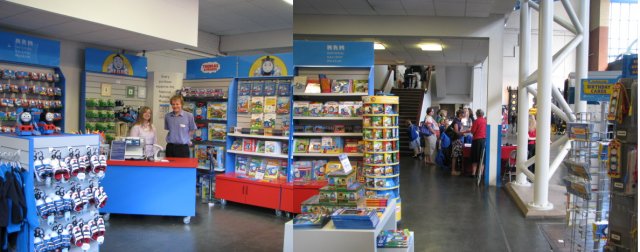Entering the NRM, it was down to the gift shops to buy a few prezzies. As the doors opened, school kids from all over were rushing into the Great Hall.
Then it was over to the train station to catch the 10:28 train to Peterborough and London Kings Cross (I got off at Peterborough). Arriving in Peterborough, I had a 45 minute wait to catch the 12:48 train to Norwich. The two-hour trip went leisurely by as I started to compose this blog, getting philosophical at times.
Between Peterborough and Ely, the land is as flat as a pancake with small knolls off in the distance populated by small villages. Drainage ditches mark the boundaries of the large farm fields. Every so often the railway line crosses large drainage canals that are 15-20’ above the fields. These canals were built centuries ago to take the land from the swamps. The thick rich black soil has been deeply tilled.
While sugar beet and barley are the dominant crops, periodically there were acres of field tomatoes and other market garden crops. Out in the field, large irrigation machines water the crops with water taken from the nearby canals. Cows, sheep, hogs and horses dot the landscape from time to time. Sugar beet dominates the fields in the same way that corn dominates back home. Whereas HFCS corn syrup is the major sweetener used in North America, the sugar beet has dominated the English sweet tooth since the 1930s. Alongside the drainage ditches and old shipping canals, anglers cast their lines into the water.
As we travlled from Ely to Thetford, the landscape changed once again. Instead of the flat-as-a-pancake fields, the countryside started to roll until we were back into the hilly country at the bottom edge of North Norfolk. The fields were lined with trees. Periodically we passed bush lots dominated by planted pine trees. In the same way that spruce dominates the building market in Canada, the knotty pine dominates the market in England.
Back in the late 1700s, the forests along the North Sea coast of Norfolk had been clear-cut to provide wood for the expansion of the Royal Navy. It was Thomas Cozens-Hardy of Letheringsett (the same person that my great-great-great grandfather worked for) who started to replant the trees on his barren estate. In 30 years he could boast that he had planted a million trees - fifty acres a year of ash, oak and other hardwoods. Today you wouldn’t know that this land had once been barren.
Throughout the trip back to Norwich and Sheringham, the shone shone brightly with only a few wisps of couds in the air.
Tomorrow we’re back at the carriage and wagon shops of the North Norfolk Railway in Weybourne.






No comments:
Post a Comment